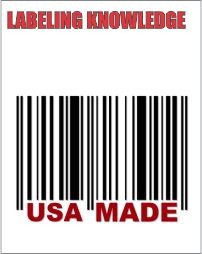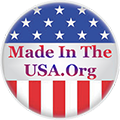Made in the USA Consumer Products Market Study

The objective of the Market Study was to determine the key drivers of the Made in USA consumer products market. The Study identified competitive advantages for US manufacturers, the ideal customer for Made in USA products, and defined core strategies to be used by US manufacturers to beat their foreign competition. The study cost tens of thousands of dollars and took multiple man years to complete.
The Study is organized into the following six Reports:
1. Consumer Demand & Pricing Sensitivity for Made in USA Products
2. Consumer Knowledge & Reliance on Labeling for Made in USA Products
3. Importance of Quality, Cost, Safety, & Reliability for Made in USA Products
4. Consumer Buying Habits & Shopping Patterns for Made in USA Products
5. Testing & Results for Implementations
6. Detailed Instructions - How to Beat Your Foreign Competition
Data
To accomplish this objective, we used three types of data, Primary Research consisting of our analysis of hundreds of products, Secondary Research that we gathered from other sources, and Surveys we conducted using our strategic questionnaires.
We analyzed the data looking for competitive advantages like, but not limited to barriers to entry, economies of scale, distribution channels and methods, promising marketing approaches, and campaigns that, if revealed to US manufacturers could be used by them to beat their foreign competition.
From these efforts, we identified and documented many things the US manufacturer should be doing to beat their foreign competition.
Analysis
The data collected, analyzed and provided with this study answered many questions including but not limited to the following:
(1) How much demand is there for Made In USA products?
(2) Where is the demand for Made In USA products?
(3) What obstacles reduce the demand for Made In USA products?
(4) When compared to imports, how should Made In USA products be priced?
(5) What trends need to be considered to remain competitive?
(6) What competitive advantages exist for manufacturers of Made In USA products?
(7) How important is Made in USA labeling and can better labeling contribute to more revenues?
Surveys
The Study includes five surveys. Our analysis of the survey data used the size of the American consumer base to make quantitative judgments regarding demand for Made in USA products. These judgments in conjunction with our discoveries were used to formulate our conclusions. Each of the five surveys were conducted among a sample of 1,000 adults comprised of 500 men and 500 women 18 years of age and older.
The online omnibus study was conducted among a demographically representative U.S. sample of 1,000 adults 18 years of age and older. Completed interviews are weighted by five variables: age, sex, geographic region, race and education to ensure reliable and accurate representation of the total U.S. population, 18 years of age and older.
The raw data are weighted by a custom-designed program which automatically develops a weighting factor for each respondent. Each respondent is assigned a single weight derived from the relationship between the actual proportion of the population based on US Census data with its specific combination of age, sex, geographic characteristics, race and education. Tabular results show both weighted and un-weighted bases.
REPORT 1. Consumer Demand & Pricing Sensitivity for Made in USA Products
 The objective of this report is to determine the demand and pricing sensitivity for Made in USA products. To accomplish this objective, we used three types of data Primary Research consisting of our analysis of hundreds of products, Secondary Research that we have used from other sources, and a Survey we conducted using our strategic questionnaire. Additionally, using our years of experience as Made in USA manufacturers, we analyzed the data and summarized our conclusions.
The objective of this report is to determine the demand and pricing sensitivity for Made in USA products. To accomplish this objective, we used three types of data Primary Research consisting of our analysis of hundreds of products, Secondary Research that we have used from other sources, and a Survey we conducted using our strategic questionnaire. Additionally, using our years of experience as Made in USA manufacturers, we analyzed the data and summarized our conclusions.The survey provided with this report and its corresponding questionnaire included questions to quantify demand for Made in USA products. Questions were also included to determine the US consumer's sensitivity to Made in USA product pricing when compared to equivalent imports. In addition, questions were included to determine and identify obstacles that are responsible for lowering the demand for Made in USA products.
Our analysis of the survey data used the size of the American consumer base to make quantitative judgments regarding demand for Made in USA products. These judgments with the pricing sensitivity and obstacle discoveries were used to formulate our conclusions. .
REPORT 2: Consumer Knowledge & Reliance on Labeling for Made in USA Products
 The objective of this report is to determine the US consumers Made In USA labeling knowledge and their reliance upon the label. To accomplish this objective, we used three types of data Primary Research consisting of our analysis of hundreds of products, Secondary Research that we have used from other sources, and a Survey we conducted using our strategic questionnaire. Additionally, using our years of experience as Made in USA manufacturers, we analyzed the data and summarized our conclusions.
The objective of this report is to determine the US consumers Made In USA labeling knowledge and their reliance upon the label. To accomplish this objective, we used three types of data Primary Research consisting of our analysis of hundreds of products, Secondary Research that we have used from other sources, and a Survey we conducted using our strategic questionnaire. Additionally, using our years of experience as Made in USA manufacturers, we analyzed the data and summarized our conclusions. The survey provided with this report and its corresponding questionnaire included questions to determine how important to the US consumer the country of origin mark is when making their purchasing decision. When considering the country of origin, questions were included to determine and identify competitive advantages that exist for Made in USA products over imports. Questions were also included to determine the US consumer's knowledge of the differences in the Made in USA and no country of origin marks. In addition, questions were included to determine and identify obstacles that are responsible for lowering the demand for Made in USA products.
Our analysis of the survey data used the size of the American consumer base to make quantitative judgments from which we formulated our conclusions.
REPORT 3: Importance of Quality, Cost, Safety, & Reliability for Made in USA Products
 The objective of this report is to determine the importance of quality, cost, safety, and reliability for Made in USA products. To accomplish this objective, we used three types of data Primary Research consisting of our analysis of hundreds of products, Secondary Research that we have used from other sources, and a Survey we conducted using our strategic questionnaire. Additionally, using our years of experience as Made in USA manufacturers, we analyzed the data and summarized our conclusions.
The objective of this report is to determine the importance of quality, cost, safety, and reliability for Made in USA products. To accomplish this objective, we used three types of data Primary Research consisting of our analysis of hundreds of products, Secondary Research that we have used from other sources, and a Survey we conducted using our strategic questionnaire. Additionally, using our years of experience as Made in USA manufacturers, we analyzed the data and summarized our conclusions. The survey provided with this report and its corresponding questionnaire included questions to determine what is most important to the US consumer when making a purchasing decision. When considering quality, cost, safety, and reliability, questions were included to determine and identify competitive advantages that exist for Made in USA products over imports. Questions were also included to determine the US consumer's thoughts about the productivity and value of US manufacturing as compared to manufacturing outside the US. In addition, questions were included to determine and identify obstacles that are responsible for lowering the demand for Made in USA products.
Our analysis of the survey data used the size of the American consumer base to make quantitative judgments from which we formulated our conclusions.
REPORT 4: Consumer Buying Habits & Shopping Patterns for Made in USA Products
 The objective of this report is to determine the consumers buying habits and shopping patterns for Made In USA products. To accomplish this objective, we used three types of data Primary Research consisting of our analysis of hundreds of products, Secondary Research that we have used from other sources, and a Survey we conducted using our strategic questionnaire. Additionally, using our years of experience as Made in USA manufacturers, we analyzed the data and summarized our conclusions.
The objective of this report is to determine the consumers buying habits and shopping patterns for Made In USA products. To accomplish this objective, we used three types of data Primary Research consisting of our analysis of hundreds of products, Secondary Research that we have used from other sources, and a Survey we conducted using our strategic questionnaire. Additionally, using our years of experience as Made in USA manufacturers, we analyzed the data and summarized our conclusions. The survey provided with this report and its corresponding questionnaire included questions to determine trends that are emerging or have emerged in shopping. When considering internet shopping, questions were included to determine and identify competitive advantages that exist for Made in USA manufactures over foreign manufacturers. Questions were also included to determine the US consumer's reliance upon and usage of the internet to meet their shopping needs.
Our analysis of the survey data used the size of the American consumer base to make quantitative judgments from which we formulated our conclusions. .
REPORT 5: Testing & Results for Implementations of Certain Findings From The Study
 The objective of this report is to determine the effectiveness of a marketing campaign we designed to grow the revenues of Made In USA manufacturers. To accomplish this objective, we conducted a Survey using our strategic questionnaire.
The objective of this report is to determine the effectiveness of a marketing campaign we designed to grow the revenues of Made In USA manufacturers. To accomplish this objective, we conducted a Survey using our strategic questionnaire. Additionally, using our years of experience as Made in USA manufacturers, we analyzed the data from this survey and summarized our conclusions.
Our analysis of the survey data used the size of the American consumer base to make quantitative judgments from which we formulated our conclusions.
The objective of this report is to determine the effectiveness of a marketing campaign we designed to grow the revenues of Made In USA manufacturers. To accomplish this objective, we conducted a Survey using our strategic questionnaire.
Additionally, using our years of experience as Made in USA manufacturers, we analyzed the data from this survey and summarized our conclusions.
Our analysis of the survey data used the size of the American consumer base to make quantitative judgments from which we formulated our conclusions.
THE PLAN & INSTRUCTIONS 6: Detailed Instructions - How to Beat Your Foreign Competition
 The Plan and instructions are provided to serve as a roadmap to higher revenue and profit for small US manufacturing businesses. In this plan, a small US manufacturing business is defined to be a business with 1-100 employees that manufacture finished goods or component parts using US labor. This plan is not specific to individual products but rather specific to the general category of Made in USA products.
The Plan and instructions are provided to serve as a roadmap to higher revenue and profit for small US manufacturing businesses. In this plan, a small US manufacturing business is defined to be a business with 1-100 employees that manufacture finished goods or component parts using US labor. This plan is not specific to individual products but rather specific to the general category of Made in USA products. Using 8 competitive advantages our research identified, this plan shows US manufacturing businesses how to grow their revenue and profit by taking market share from their foreign competition. Discovering and communicating how to do this was accomplished by a group of associates with extensive US manufacturing training and experience.
This group is highly experienced in administration, accounting, finance, technology, and manufacturing operations. They have years of success acquiring, integrating, and organically growing US based businesses. The group began its efforts by analyzing the US consumer. This was accomplished by gathering data from surveys of a demographically representative sample of the US. This data clearly showed US consumer attitudes about Made in USA products had changed.
